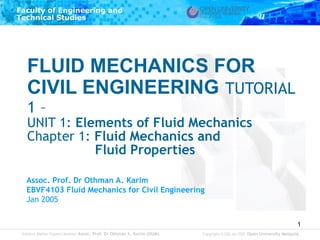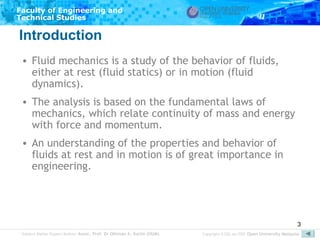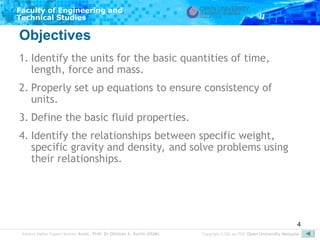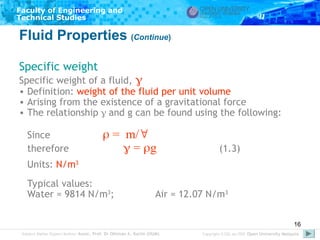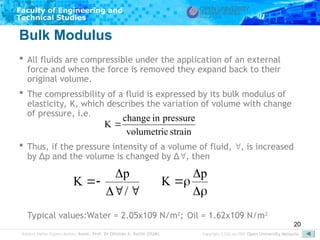EBVF4103 (Chapter 1) Fluid Mechanics for Civil Engineering.ppt
- 1. Copyright ┬® ODL Jan 2005 Open University Malaysia 1 Subject Matter Expert/Author: Assoc. Prof. Dr Othman A. Karim (OUM) Faculty of Engineering and Technical Studies FLUID MECHANICS FOR CIVIL ENGINEERING TUTORIAL 1 ŌĆō UNIT 1: Elements of Fluid Mechanics Chapter 1: Fluid Mechanics and Fluid Properties Assoc. Prof. Dr Othman A. Karim EBVF4103 Fluid Mechanics for Civil Engineering Jan 2005
- 2. 2 Subject Matter Expert/Author: Assoc. Prof. Dr Othman A. Karim (OUM) Faculty of Engineering and Technical Studies Copyright ┬® ODL Jan 2005 Open University Malaysia SEQUENCE OF CHAPTER 1 Introduction Objectives 1.1 Definition of A Fluid Shear stress in moving fluid Differences between liquid and gases Newtonian and Non-Newtonian Fluid 1.2 Engineering Units 1.3 Fluid Properties Vapor Pressure Engineering significance of vapor pressure Surface Tension Capillarity Example 1.2 Example 1.3 Summary
- 3. 3 Subject Matter Expert/Author: Assoc. Prof. Dr Othman A. Karim (OUM) Faculty of Engineering and Technical Studies Copyright ┬® ODL Jan 2005 Open University Malaysia Introduction ŌĆó Fluid mechanics is a study of the behavior of fluids, either at rest (fluid statics) or in motion (fluid dynamics). ŌĆó The analysis is based on the fundamental laws of mechanics, which relate continuity of mass and energy with force and momentum. ŌĆó An understanding of the properties and behavior of fluids at rest and in motion is of great importance in engineering.
- 4. 4 Subject Matter Expert/Author: Assoc. Prof. Dr Othman A. Karim (OUM) Faculty of Engineering and Technical Studies Copyright ┬® ODL Jan 2005 Open University Malaysia 1. Identify the units for the basic quantities of time, length, force and mass. 2. Properly set up equations to ensure consistency of units. 3. Define the basic fluid properties. 4. Identify the relationships between specific weight, specific gravity and density, and solve problems using their relationships. Objectives
- 5. Copyright ┬® ODL Jan 2005 Open University Malaysia 5 Subject Matter Expert/Author: Assoc. Prof. Dr Othman A. Karim (OUM) Faculty of Engineering and Technical Studies 1.1 Definition of Fluid ’é¦ A fluid is a substance, which deforms continuously, or flows, when subjected to shearing force ’é¦ In fact if a shear stress is acting on a fluid it will flow and if a fluid is at rest there is no shear stress acting on it. Fluid Flow Shear stress ŌĆō Yes Fluid Rest Shear stress ŌĆō No
- 6. Copyright ┬® ODL Jan 2005 Open University Malaysia 6 Subject Matter Expert/Author: Assoc. Prof. Dr Othman A. Karim (OUM) Faculty of Engineering and Technical Studies Shear stress in moving fluid ŌĆó If fluid is in motion, shear stress are developed if the particles of the fluid move relative to each other. Adjacent particles have different velocities, causing the shape of the fluid to become distorted ŌĆó On the other hand, the velocity of the fluid is the same at every point, no shear stress will be produced, the fluid particles are at rest relative to each other. Moving plate Shear force Fluid particles New particle position Fixed surface
- 7. Copyright ┬® ODL Jan 2005 Open University Malaysia 7 Subject Matter Expert/Author: Assoc. Prof. Dr Othman A. Karim (OUM) Faculty of Engineering and Technical Studies Differences between liquid and gases Liquid Gases Difficult to compress and often regarded as incompressible Easily to compress ŌĆō changes of volume is large, cannot normally be neglected and are related to temperature Occupies a fixed volume and will take the shape of the container No fixed volume, it changes volume to expand to fill the containing vessels A free surface is formed if the volume of container is greater than the liquid. Completely fill the vessel so that no free surface is formed.
- 8. 8 Subject Matter Expert/Author: Assoc. Prof. Dr Othman A. Karim (OUM) Faculty of Engineering and Technical Studies Copyright ┬® ODL Jan 2005 Open University Malaysia Example: Air Water Oil Gasoline Alcohol Kerosene Benzene Glycerine Fluid NewtonŌĆÖs law of viscosity Newtonian fluids obey refer NewtonŌĆÖsŌĆÖ law of viscosity is given by; dy du ’üŁ ’ĆĮ ’ü┤ (1.1) ŌĆó The viscosity ’üŁ is a function only of the condition of the fluid, particularly its temperature. ŌĆó The magnitude of the velocity gradient (du/dy) has no effect on the magnitude of ’üŁ. ’ü┤ = shear stress ’üŁ = viscosity of fluid du/dy = shear rate, rate of strain or velocity gradient Newtonian and Non-Newtonian Fluid
- 9. 9 Subject Matter Expert/Author: Assoc. Prof. Dr Othman A. Karim (OUM) Faculty of Engineering and Technical Studies Copyright ┬® ODL Jan 2005 Open University Malaysia Fluid NewtonŌĆÖs law of viscosity Non- Newtonian fluids Do not obey ŌĆóThe viscosity of the non-Newtonian fluid is dependent on the velocity gradient as well as the condition of the fluid. Newtonian Fluids ’é¦ a linear relationship between shear stress and the velocity gradient (rate of shear), ’é¦ the slope is constant ’é¦ the viscosity is constant non-Newtonian fluids ’é¦ slope of the curves for non-Newtonian fluids varies Newtonian and Non-Newtonian Fluid
- 10. 10 Subject Matter Expert/Author: Assoc. Prof. Dr Othman A. Karim (OUM) Faculty of Engineering and Technical Studies Copyright ┬® ODL Jan 2005 Open University Malaysia Figure 1.1 Shear stress vs. velocity gradient Bingham plastic : resist a small shear stress but flow easily under large shear stresses, e.g. sewage sludge, toothpaste, and jellies. Pseudo plastic : most non-Newtonian fluids fall under this group. Viscosity decreases with increasing velocity gradient, e.g. colloidal substances like clay, milk, and cement. Dilatants : viscosity decreases with increasing velocity gradient, e.g. quicksand.
- 11. 11 Subject Matter Expert/Author: Assoc. Prof. Dr Othman A. Karim (OUM) Faculty of Engineering and Technical Studies Copyright ┬® ODL Jan 2005 Open University Malaysia Primary Units In fluid mechanics we are generally only interested in the top four units from this table. 1.2 Engineering Units Quantity SI Unit Length Metre, m Mass Kilogram, kg Time Seconds, s Temperature Kelvin, K Current Ampere, A Luminosity Candela
- 12. 12 Subject Matter Expert/Author: Assoc. Prof. Dr Othman A. Karim (OUM) Faculty of Engineering and Technical Studies Copyright ┬® ODL Jan 2005 Open University Malaysia Derived Units Quantity SI Unit velocity m/s - acceleration m/s2 - force Newton (N) N = kg.m/s2 energy (or work) Joule (J) J = N.m = kg.m2 /s2 power Watt (W) W = N.m/s = kg.m2 /s3 pressure (or stress) Pascal (P) P = N/m2 = kg/m/s2 density kg/m3 - specific weight N/m3 = kg/m2 /s2 N/m3 = kg/m2 /s2 relative density a ratio (no units) dimensionless viscosity N.s/m2 N.s/m2 = kg/m/s surface tension N/m N/m = kg/s2
- 13. 13 Subject Matter Expert/Author: Assoc. Prof. Dr Othman A. Karim (OUM) Faculty of Engineering and Technical Studies Copyright ┬® ODL Jan 2005 Open University Malaysia Unit Cancellation Procedure 1. Solve the equation algebraically for the desired terms. 2. Decide on the proper units of the result. 3. Substitute known values, including units. 4. Cancel units that appear in both the numerator and denominator of any term. 5. Use correct conversion factors to eliminate unwanted units and obtain the proper units as described in Step 2. 6. Perform the calculations.
- 14. 14 Subject Matter Expert/Author: Assoc. Prof. Dr Othman A. Karim (OUM) Faculty of Engineering and Technical Studies Copyright ┬® ODL Jan 2005 Open University Malaysia Example 1.1 Given m = 80 kg and a=10 m/s2 . Find the force Solution ’é¦ F = ma ’é¦ F = 80 kg x 10 m/s2 = 800 kg.m/s2 ’é¦ F= 800N
- 15. 15 Subject Matter Expert/Author: Assoc. Prof. Dr Othman A. Karim (OUM) Faculty of Engineering and Technical Studies Copyright ┬® ODL Jan 2005 Open University Malaysia 1.3 Fluid Properties Density Density of a fluid, ’ü▓, Definition: mass per unit volume, ŌĆó slightly affected by changes in temperature and pressure. ’ü▓ = mass/volume = m/’Ćó (1.2) Units: kg/m3 Typical values: Water = 1000 kg/m3 ; Air = 1.23 kg/m3
- 16. 16 Subject Matter Expert/Author: Assoc. Prof. Dr Othman A. Karim (OUM) Faculty of Engineering and Technical Studies Copyright ┬® ODL Jan 2005 Open University Malaysia Fluid Properties (Continue) Specific weight Specific weight of a fluid, ’ü¦ ŌĆó Definition: weight of the fluid per unit volume ŌĆó Arising from the existence of a gravitational force ŌĆó The relationship ’ü¦ and g can be found using the following: Since ’ü▓ = m/’Ćó therefore ’ü¦ = ’ü▓g (1.3) Units: N/m3 Typical values: Water = 9814 N/m3 ; Air = 12.07 N/m3
- 17. 17 Subject Matter Expert/Author: Assoc. Prof. Dr Othman A. Karim (OUM) Faculty of Engineering and Technical Studies Copyright ┬® ODL Jan 2005 Open University Malaysia Specific gravity The specific gravity (or relative density) can be defined in two ways: Definition 1: A ratio of the density of a substance to the density of water at standard temperature (4’é░C) and atmospheric pressure, or Definition 2: A ratio of the specific weight of a substance to the specific weight of water at standard temperature (4’é░C) and atmospheric pressure. (1.4) Unit: dimensionless. C w s C w s SG ’é░ ’é░ ’ü¦ ’ü¦ ’ĆĮ ’ü▓ ’ü▓ ’ĆĮ 4 4 @ @ Fluid Properties (Continue)
- 18. 18 Subject Matter Expert/Author: Assoc. Prof. Dr Othman A. Karim (OUM) Faculty of Engineering and Technical Studies Copyright ┬® ODL Jan 2005 Open University Malaysia Viscosity ŌĆó Viscosity, ’üŁ, is the property of a fluid, due to cohesion and interaction between molecules, which offers resistance to shear deformation. ŌĆó Different fluids deform at different rates under the same shear stress. The ease with which a fluid pours is an indication of its viscosity. Fluid with a high viscosity such as syrup deforms more slowly than fluid with a low viscosity such as water. The viscosity is also known as dynamic viscosity. Units: N.s/m2 or kg/m/s Typical values: Water = 1.14x10-3 kg/m/s; Air = 1.78x10-5 kg/m/s Fluid Properties (Continue)
- 19. 19 Subject Matter Expert/Author: Assoc. Prof. Dr Othman A. Karim (OUM) Faculty of Engineering and Technical Studies Copyright ┬® ODL Jan 2005 Open University Malaysia Kinematic viscosity, ’ü« Definition: is the ratio of the viscosity to the density; ŌĆó will be found to be important in cases in which significant viscous and gravitational forces exist. Units: m2 /s Typical values: Water = 1.14x10-6 m2/s; Air = 1.46x10-5 m2/s; In general, viscosity of liquids with temperature, whereas viscosity of gases with in temperature. ’ü▓ ’üŁ ’ĆĮ ’ü« /
- 20. 20 Subject Matter Expert/Author: Assoc. Prof. Dr Othman A. Karim (OUM) Faculty of Engineering and Technical Studies Copyright ┬® ODL Jan 2005 Open University Malaysia Bulk Modulus ’é¦ All fluids are compressible under the application of an external force and when the force is removed they expand back to their original volume. ’é¦ The compressibility of a fluid is expressed by its bulk modulus of elasticity, K, which describes the variation of volume with change of pressure, i.e. ’é¦ Thus, if the pressure intensity of a volume of fluid, ’Ćó, is increased by ╬öp and the volume is changed by ╬ö’Ćó, then Typical values:Water = 2.05x109 N/m2 ; Oil = 1.62x109 N/m2 strain volumetric pressure in change K ’ĆĮ ’Ćó ’Ćó ’üä ’üä ’ĆŁ ’ĆĮ / p K ’ü▓ ’üä ’üä ’ü▓ ’ĆĮ p K
- 21. 21 Subject Matter Expert/Author: Assoc. Prof. Dr Othman A. Karim (OUM) Faculty of Engineering and Technical Studies Copyright ┬® ODL Jan 2005 Open University Malaysia Vapor Pressure ’é¦ A liquid in a closed container is subjected to a partial vapor pressure in the space above the liquid due to the escaping molecules from the surface; ’é¦ It reaches a stage of equilibrium when this pressure reaches saturated vapor pressure. ’é¦ Since this depends upon molecular activity, which is a function of temperature, the vapor pressure of a fluid also depends on its temperature and increases with it. ’é¦ If the pressure above a liquid reaches the vapor pressure of the liquid, boiling occurs; for example if the pressure is reduced sufficiently boiling may occur at room temperature.
- 22. 22 Subject Matter Expert/Author: Assoc. Prof. Dr Othman A. Karim (OUM) Faculty of Engineering and Technical Studies Copyright ┬® ODL Jan 2005 Open University Malaysia Engineering significance of vapor pressure ’é¦ In a closed hydraulic system, Ex. in pipelines or pumps, water vaporizes rapidly in regions where the pressure drops below the vapor pressure. ’é¦ There will be local boiling and a cloud of vapor bubbles will form. ’é¦ This phenomenon is known as cavitations, and can cause serious problems, since the flow of fluid can sweep this cloud of bubbles on into an area of higher pressure where the bubbles will collapse suddenly. ’é¦ If this should occur in contact with a solid surface, very serious damage can result due to the very large force with which the liquid hits the surface. ’é¦ Cavitations can affect the performance of hydraulic machinery such as pumps, turbines and propellers, and the impact of collapsing bubbles can cause local erosion of metal surface. ’é¦ Cavitations in a closed hydraulic system can be avoided by maintaining the pressure above the vapor pressure everywhere in the system.
- 23. 23 Subject Matter Expert/Author: Assoc. Prof. Dr Othman A. Karim (OUM) Faculty of Engineering and Technical Studies Copyright ┬® ODL Jan 2005 Open University Malaysia Surface Tension ’é¦ Liquids possess the properties of cohesion and adhesion due to molecular attraction. ’é¦ Due to the property of cohesion, liquids can resist small tensile forces at the interface between the liquid and air, known as surface tension, ’ü│. ’é¦ Surface tension is defined as force per unit length, and its unit is N/m. ’é¦ The reason for the existence of this force arises from intermolecular attraction. In the body of the liquid (Fig. 1.2a), a molecule is surrounded by other molecules and intermolecular forces are symmetrical and in equilibrium. ’é¦ At the surface of the liquid (Fig. 1.2b), a molecule has this force acting only through 180’é░. ’é¦ This imbalance forces means that the molecules at the surface tend to be drawn together, and they act rather like a very thin membrane under tension. ’é¦ This causes a slight deformation at the surface of the liquid (the meniscus effect). Figure 1.2: Surface Tension
- 24. 24 Subject Matter Expert/Author: Assoc. Prof. Dr Othman A. Karim (OUM) Faculty of Engineering and Technical Studies Copyright ┬® ODL Jan 2005 Open University Malaysia ’é¦ A steel needle floating on water, the spherical shape of dewdrops, and the rise or fall of liquid in capillary tubes is the results of the surface tension. ’é¦ Surface tension is usually very small compared with other forces in fluid flows (e.g. surface tension for water at 20’é░C is 0.0728 N/m). ’é¦ Surface tension,’ü│, increases the pressure within a droplet of liquid. The internal pressure, P, balancing the surface tensional force of a spherical droplet of radius r, is given by r 2 P ’ü│ ’ĆĮ (1.7)
- 25. 25 Subject Matter Expert/Author: Assoc. Prof. Dr Othman A. Karim (OUM) Faculty of Engineering and Technical Studies Copyright ┬® ODL Jan 2005 Open University Malaysia Capillarity ŌĆó The surface tension leads to the phenomenon known as capillarity ŌĆó where a column of liquid in a tube is supported in the absence of an externally applied pressure. ŌĆó Rise or fall of a liquid in a capillary tube is caused by surface tension and depends on the relative magnitude of cohesion of the liquid and the adhesion of the liquid to the walls of the containing vessels. ŌĆó Liquid rise in tubes if they wet a surface (adhesion > cohesion), such as water, and fall in tubes that do not wet (cohesion > adhesion), such as mercury. ŌĆó Capillarity is important when using tubes smaller than 10 mm (3/8 in.). ŌĆó For tube larger than 12 mm (1/2 in.) capillarity effects are negligible.
- 26. 26 Subject Matter Expert/Author: Assoc. Prof. Dr Othman A. Karim (OUM) Faculty of Engineering and Technical Studies Copyright ┬® ODL Jan 2005 Open University Malaysia Figure 1.3 Capillary actions r cos 2 h ’ü¦ ’ü▒ ’ü│ ’ĆĮ (1.8) where h = height of capillary rise (or depression) ’ü│ = surface tension ’ü▒ = wetting (contact) angle ’ü¦ = specific weight of liquid r = radius of tube
- 27. 27 Subject Matter Expert/Author: Assoc. Prof. Dr Othman A. Karim (OUM) Faculty of Engineering and Technical Studies Copyright ┬® ODL Jan 2005 Open University Malaysia A reservoir of oil has a mass of 825 kg. The reservoir has a volume of 0.917 m3 . Compute the density, specific weight, and specific gravity of the oil. Solution: 3 / 900 917 . 0 825 m kg m volume mass oil ’ĆĮ ’ĆĮ ’Ćó ’ĆĮ ’ĆĮ ’ü▓ 3 oil m / N 8829 81 . 9 x 900 g mg volume weight ’ĆĮ ’ĆĮ ’ü▓ ’ĆĮ ’Ćó ’ĆĮ ’ĆĮ ’ü¦ 9 . 0 1000 900 SG C 4 @ w oil oil ’ĆĮ ’ĆĮ ’ü▓ ’ü▓ ’ĆĮ ’é░ Example 1.2
- 28. 28 Subject Matter Expert/Author: Assoc. Prof. Dr Othman A. Karim (OUM) Faculty of Engineering and Technical Studies Copyright ┬® ODL Jan 2005 Open University Malaysia Water has a surface tension of 0.4 N/m. In a 3-mm diameter vertical tube, if the liquid rises 6 mm above the liquid outside the tube, calculate the wetting angle. Solution Capillary rise due to surface tension is given by; r cos 2 h ’ü¦ ’ü▒ ’ü│ ’ĆĮ ’ü▒ = 83.7’é░ 4 . 0 x 2 006 . 0 x 0015 . 0 x 9810 2 rh cos ’ĆĮ ’ü│ ’ü¦ ’ĆĮ ’ü▒ ’ü£ Example 1.3
- 29. 29 Subject Matter Expert/Author: Assoc. Prof. Dr Othman A. Karim (OUM) Faculty of Engineering and Technical Studies Copyright ┬® ODL Jan 2005 Open University Malaysia This chapter has summarized on the aspect below: ’é¦ Understanding of a fluid ’é¦ The differences between the behaviours of liquid and gases ’é¦ Newtonian and non-Newtonian fluid were identified ’é¦ Engineering unit of SI unit were discussed ’é¦ Fluid properties of density, specific weight, specific gravity, viscosity and bulk modulus were outlined and taken up. ’é¦ Discussion on the vapor pressure of the liquid ’é¦ Surface tension ’é¦ Capillarity phenomena Summary
- 30. 30 Subject Matter Expert/Author: Assoc. Prof. Dr Othman A. Karim (OUM) Faculty of Engineering and Technical Studies Copyright ┬® ODL Jan 2005 Open University Malaysia Learning Materials http://hyperphysics.phy-astr.gsu.edu/hbase/surten.html http://www.cartage.org.lb/en/themes/Sciences/Physics/Mechanics/ FluidMechanics/FluidMechanics/NatureFluids/NatureFluids.htm
- 31. 31 Subject Matter Expert/Author: Assoc. Prof. Dr Othman A. Karim (OUM) Faculty of Engineering and Technical Studies Copyright ┬® ODL Jan 2005 Open University Malaysia Thank You

